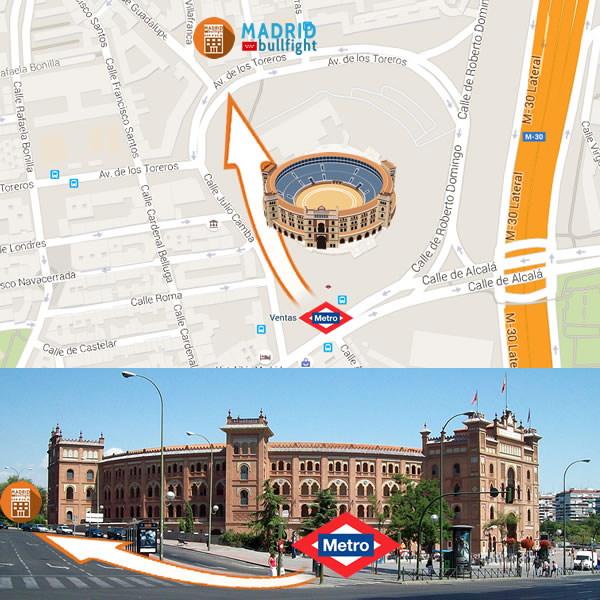The Bullfight is one of the national celebrations of Spain, with its cultural values also being recognised as important. In the arena, the bullfighter confronts the bull, a symbol of fury and strength, and risking his life, he studies, dominates and, finally, kills it with a sword.
The nobleness of the fight, the fierceness of the bull, and the courage of the bullfighter have inspired many Spanish artists. To truly understand Spain and its people, you have to see a bullfight, because all what happens in the bullring inspires the Spanish art, explains Spanish history and determines the Spanish character.
The Spanish passion for bullfight is very old. In the rupestrian paintings the bull had a very important presence, but it wasn’t until the end of the seventieth century that bullfighting was understood as we do nowadays.
The bullfight is divided into three “tercios”. Before the first one begins, the bullfighters have to parade around the arena in a very emotive walk called the “paseillo”.
The first “tercio” is called the “tercio de varas”, in which the bullfighter faces the bull for the first time with the cape in order to study its movements for the successive charges at the bull. In this “tercio” the “picador” weakens the bull with a lance in order to make a more equivalent fight. Meanwhile, the “matador” makes beautiful and different passes with the cape such as: veronica, chicuelina, faroles, gaonera…etc.
The second “tercio” is the “tercio de banderillas”. In this part the “banderilleros” sting the bull with a small lance called “banderilla” on the top of its back. This is a very spectacular moment, in which the “banderilleros” meet the bull head-on in a very brave pass.
The last and most important “tercio” is the “tercio del momento supremo”. In this special moment the bullfighter has to make the “faena” with the “muleta”, usng a variety of brave and beautiful lances to prepare the bull for the most exciting and dangerous moment of the show: the bull´s death.


This is a basic guide about how to buy tickets for bullfighting, after our 50 year experience. These are the Frequently asked questions (FAQ)
1. Wich is the best way to book my tickets for a bullfight?
The best way is booking the tickets with us, some weeks or some months before the fight. The tickets will be waiting for you at Teyci´s office the same day of the bullfight, from 11:00 AM till the beginning of the fight.
2. Can I print the tickets?
No, our tickets are already printed and can´t be printed by you.
3. Can I get my tickets delivered to my Hotel?
Yes, when filling up the form, you must select Office Pick Up or hotel delivery.
4. Are my tickets together?
All tickets are numerated, there are assigned seats. All tickets booking in the same order line are always together. If you can select, for exemple, 20 tickets in a single line, the 20 tickets will be together. If you book 20 tickets separatelly, they can be together or not.
5. What do “Sombra”, “Sol”, “Sol/Sombra” and Tendido mean?
Sombra means Shade, Sol means Sunny Section, Sol/Sombra is a little part of the bullring, half in Sun, half in Shade. Tendido is the name of the most suitable rows (depending on the bullring, from Row 1 to Row 10 or 20 or more).
6. Most of the fights start at 19:00 PM. Should I book tickets in the sunny section?
The sun has been heating the tendidos for the whole day. From May to August, you can be in the sunny section at 40º or more. For children or aged people, booking tickets in the shade (sombra) is highly recommended.
7. Are there VIP tickets?
Yes, they are called Barreras (Front Row), Contrabarreras (Second Front Row), and Delanteras Bajas (Third Front Row). Please don´t consider tickets in the Sol as VIP tickets. They are not.
8. When does the season begin in Spain?
The season begins in mid-March and ends in mid-October.
9.What time do the bullfights begin?
The start of a bullfight is determined by the hours of sunlight, and is confirmed by the Plaza some weeks before each festivity. Normally, bullfights begin at 17:00 in March, gradually starting later, up until 19:00 in summer, and commencing around 17:30 in the autumn.
10. What is a “novillada” or “corrida de novillos”?
A novillada or corrida de novillos is a training fight, a bullfight between young bulls and matadors who have not yet become fully qualified. The prices are approximately half of those for the normal bullfights. In Madrid they still arouse a lot of excitement. If you arenot familiar with bullfighting, you willnot see the difference.
11. Can children attend the bullfight?
Yes, so long as they are accompanied by adults. There are no special prices for children.
12. How long does a bullfight last?
A bullfight can last from one and a half to two and a half hours (1 ½ – 2 ½ hours).
13. What happens if it rains?
The bullfight can still take place if it rains. Only in the case of hard, persistent rain would it be cancelled. If it is suspended before the beginning of that day’s bullfight, customers will always receive a refund of the ticket price at the respective location, done by submitting the tickets directly at the bullring. If they suspend the bullfight after it has already started (even if only one bull has been fought), there is no possibility of a refund. Less than a 1% of the bullfights are suspended because of the rain.
14. Can I enter after the bullfight has already started?
Yes, but only during the intervals between bulls.
15. Can I take photos?
Yes, there are no limitations on photography.
16. How much in advance should tickets be purchased?
The further in advance you buy your tickets, the greater the possibility for choosing the best seats.
Our office is located in Villafranca 4, 150 meters away from the bullring.
Tickets are to be picked up the same day of the bullfight from 12:00 till 45 minutes after the starting time
During San Isidro Festival our office is open every day from 12.00 till 19:45.
